The HTC One (M8) Review
by Anand Lal Shimpi & Joshua Ho on March 26, 2014 7:00 PM EST- Posted in
- Smartphones
- HTC
- Mobile
- HTC One
Battery Life
The new One features an integrated 3.8V 2600mAh battery (9.88 Wh), a 13% increase in capacity compared to the previous model. The battery comparison isn’t that simple however. The M8 has a larger display (5” vs 4.7”) but it also has a higher performing and more power efficient SoC (Snapdragon 801 vs. 600). To find out how the new One stacks up against its predecessor, we turn to a mix of old and new battery life tests to help better characterize the device.
We’ll start with our standard browser based battery life tests. Keep in mind here these tests are as much about replicating a particular CPU profile as they are about loading specific web pages in order.
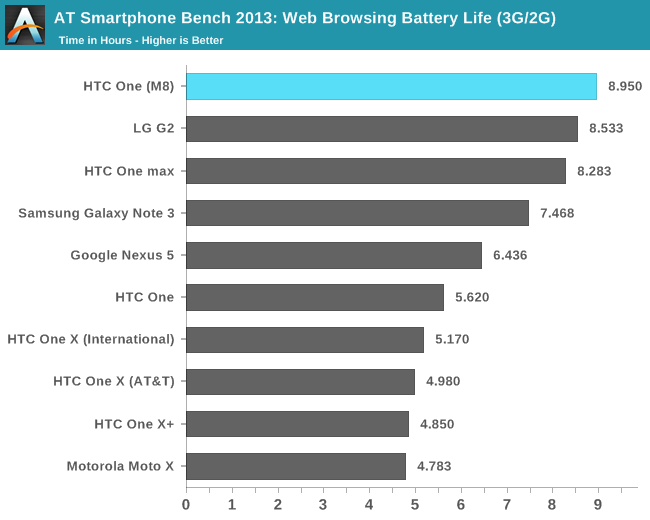
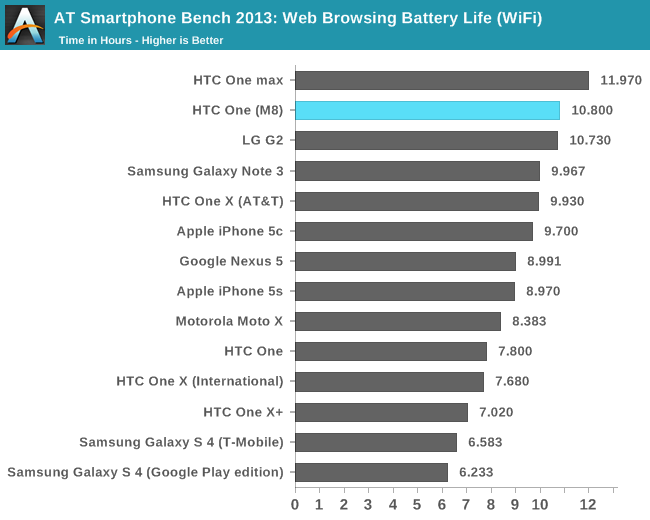
We saw a substantial gain in battery life with Snapdragon 800, and 801 extends that even further. For the same, relatively light (yet constant) workload, the M8 improves battery life over the M7 by as much as 71%. On WiFi the advantage drops to only 38%, but we’re still talking about absolutely huge generational gains.
A constant workload is only one part of the story though. More often than not, when you’re faced with faster compute you end up doing more. To see what the other extreme of battery life looks like I turned to two canned tests: BaseMark OS II and GFXBench 3.0.
I ran both of these tests under the same controlled conditions we always use, with all displays calibrated to 200 nits. BaseMark OS II runs through a bunch of CPU and storage benchmarks (basically the same tests used for the BaseMark OS II system and memory tests), as fast as possible, until the battery dies.
I like this benchmark as it gives us an indication of worst case battery life if you’re absolutely hammering the CPU (and storage) relentlessly.
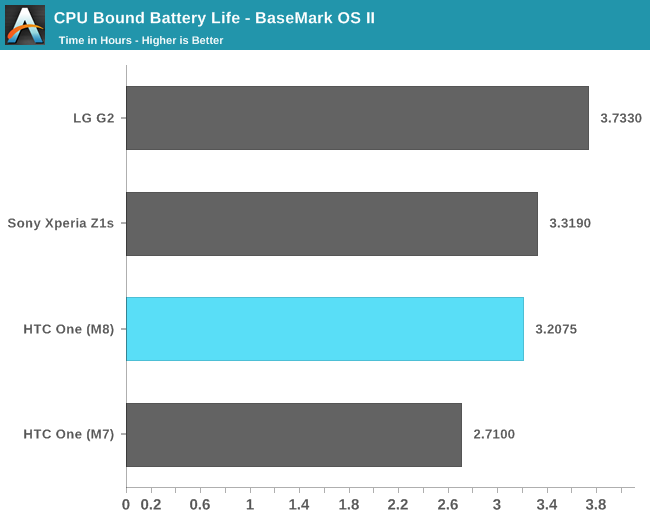
Despite the faster CPU cores, the M8’s battery life actually goes up compared to M7. Here we’re really seeing the benefits of 801’s updated 28nm HPm process compared to the Snapdragon 600’s 28nm LP process.
GFXBench provides a similar test, with effectively uncapped performance (on today’s devices at least since we’re not hitting v-sync limits), but stressing the GPU instead of the CPU. Here we’re running the T-Rex HD benchmark, onscreen, until the battery dies.

This is the first and only test we’ve got here that shows a regression in battery life compared to M7. The M8 loses about 6% of runtime compared to the M7, despite having a larger battery. Now look at what happens if we look at performance at the end of the run:
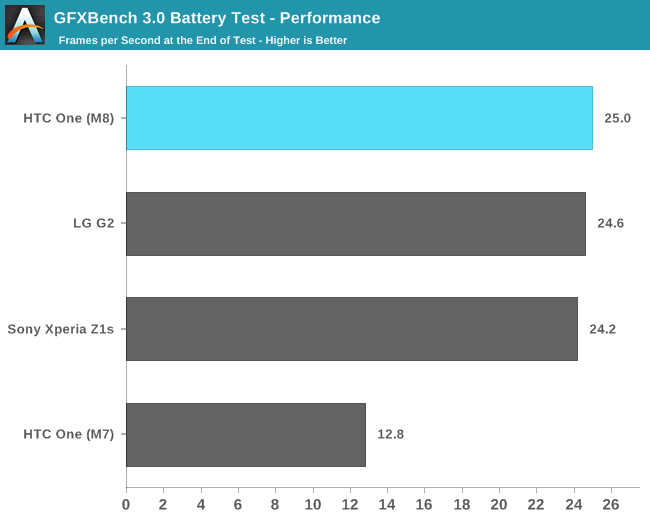
Now the M8’s battery life regression doesn’t look so bad. You give up 6% of runtime but you get almost twice the performance compared to M7. Snapdragon 801 is just a huge upgrade compared to 600.
Charge Time
The M8 features a Qualcomm Quick Charge 2.0 enabled PMIC, which enables faster battery charge times through higher voltage charging. Unfortunately the in-box wall adapter is only Quick Charge 1.5 compliant so you'll only pull 7.5W from the wall. HTC expects to offer a Quick Charge 2.0 compliant power adapter later this year.
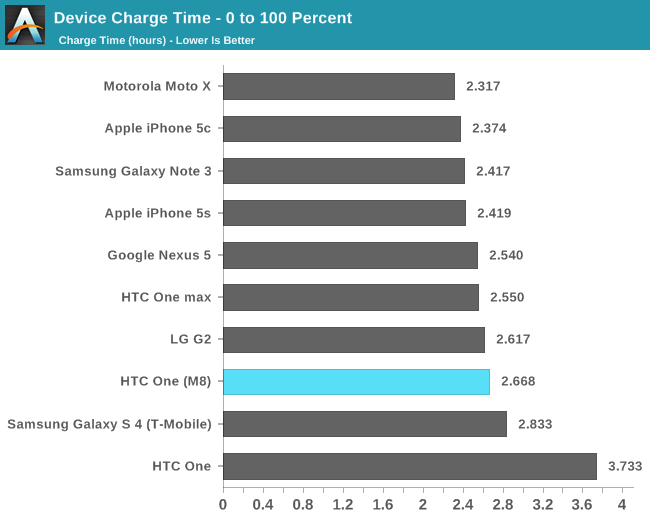
The M8's charge time is a bit slow compared to what we've seen from other devices with larger batteries.










222 Comments
View All Comments
piroroadkill - Thursday, March 27, 2014 - link
Agreed. Z2 is the real Android flagship.Blairh - Thursday, March 27, 2014 - link
Very odd that not a single word was written about BoomSound.M8 is a big let down IMO. I would recommend it, but personally I find it too tall and heavy this round. A hypothetical 5" screen on the same footprint as the M7 would have been superior. Poor camera, ugly bezel, too tall. I hope HTC comes back stronger next year.
flashbacck - Thursday, March 27, 2014 - link
I've been say'n, if they're going to cheat on performance benchmarks, you should use those same benchmarks to measure battery life!flashbacck - Thursday, March 27, 2014 - link
Hmm. The low light seems ok, but it's not dramatically better than anything else.bhupatib - Thursday, March 27, 2014 - link
Disappointed that Anand didn't do any audio quality test. GSMArena's analysis suggests impeccable audio output but I really doubt their testing methodology. But I'm happy HTC gave us bottom headphone jacks! Don't troll me on that, but I just think USB and headphone jack belong at the bottom. I know G2 does that too but going by AT's audio benchmark, it has less than stellar audio quality.Someone posted about the next One mini being the more reasonable buy and I agree (unless the next Moto X beats it to it). We won't get SD801, but if it looks just as good with the same port placement, audio quality and battery life, great ! Paying extra for that gimmicky dual camera to get the kind of effects I was doing when I first learnt Photoshop - bad, amateurish, no thank you! I'm not averse to camera features on a phone, I just think HTC missed an opportunity to implement something awesome instead of creating another fancy name (UltraPixel).
My take? A single, large sensor (at least 1/2.3", ideally 1") camera optimized primarily for shooting 4K videos. Why? A frame grab from a 4K video with well implemented codec has just as much detail as any good 8MP still shot - so 4K gets you the eyeballs and without any further effort you get decent stills quality. SD801 is capable enough, HTC just needed to add improved optical stabilization and at least 50mbps H.264 profile. That, along with 1080p60 and 720p120, would have been much more logical.
Pretty certain iPhone 6 will have some advanced OIS and the fusion of videography and photography is the way to go in the 4K era.
Anand Lal Shimpi - Thursday, March 27, 2014 - link
Audio quality testing happens out of a physically different location, we're working on it next though :)Laxaa - Thursday, March 27, 2014 - link
Does it still have the "HDR Mics" as the M7 had? The one's that doesn't distort loud noises?Biln3 - Thursday, March 27, 2014 - link
i know the screen in the new one is .3" bigger but aren't they effectively the same size since the new one has screen shrinking onscreen buttons?hughlle - Thursday, March 27, 2014 - link
Rather what i was thinking. They removed the old buttons, but maintained the black bar. It all seems rather counter productive.TrackSmart - Thursday, March 27, 2014 - link
BINGO! This *really* annoys me the One M8! The new display makes the phone larger, but doesn't provide extra screen real estate. It's a lose-lose situation.Sure, the on-screen buttons are more versatile and can be updated with the software, but lost screen real estate is a painful compromise. Especially, when you the phone doesn't get any smaller for the loss of capacitive buttons. The Moto X is probably the only flagship device that actually used on-screen buttons as a way to reduce phone size. Almost every other implementation was a lost opportunity.